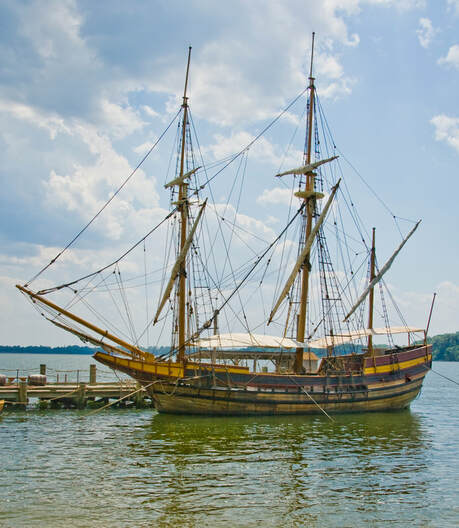
By Nancy Bruce
On St. Cecilius Day, 22 November, 1633, the fast and large ship, the London Ark and the smaller, slower ship, the Maryland Dove, set sail from the Cowes, at the lower end of the Isle of Wight. These two ships were on an expedition to found the first Roman Catholic colony and the first of the English proprietary colonies in North America. On 25 March 1634, these two ships landed at St. Clements Island, Maryland.
While there is no documented list of all the passengers on these two ships, there is evidence that one William Browne came on The Ark as a manservant and shoemaker to Captain Thomas Cornwalys. He is believed to be between 10 and 13 years old at the time. William accumulated a large estate. He had many slaves and thirteen hundred acres of land. There are records of William being sued many times and of him suing others frequently.
William Browne died 28 February 1665 leaving a son and a daughter as his heirs.
In the 1720s, a descendant, William Browne, moved to the Monocacy Settlement, where he served as constable. In 1742, this William Browne signed the petition for the formation of Frederick County.
Thomas Brown was the sixth generation of the family in America. Brown was a corporal in the 2nd Maryland Regiment during the Revolutionary War. He married Hannah Pittinger and fathered nine children. Thomas died in the late 1780s; his burial site is unknown.
Following Thomas's death, Hannah and the couple's children built a home along Monahan Road south of Foxville. As the family grew the village became known as Brownsville. When Hannah died she was buried on her homestead which is now known as the Brown's Cemetery. Some of the foundation rocks from her old cottage are still intact there.
Photo: A replica of the Maryland Dove at St. Mary's City, Maryland.
On St. Cecilius Day, 22 November, 1633, the fast and large ship, the London Ark and the smaller, slower ship, the Maryland Dove, set sail from the Cowes, at the lower end of the Isle of Wight. These two ships were on an expedition to found the first Roman Catholic colony and the first of the English proprietary colonies in North America. On 25 March 1634, these two ships landed at St. Clements Island, Maryland.
While there is no documented list of all the passengers on these two ships, there is evidence that one William Browne came on The Ark as a manservant and shoemaker to Captain Thomas Cornwalys. He is believed to be between 10 and 13 years old at the time. William accumulated a large estate. He had many slaves and thirteen hundred acres of land. There are records of William being sued many times and of him suing others frequently.
William Browne died 28 February 1665 leaving a son and a daughter as his heirs.
In the 1720s, a descendant, William Browne, moved to the Monocacy Settlement, where he served as constable. In 1742, this William Browne signed the petition for the formation of Frederick County.
Thomas Brown was the sixth generation of the family in America. Brown was a corporal in the 2nd Maryland Regiment during the Revolutionary War. He married Hannah Pittinger and fathered nine children. Thomas died in the late 1780s; his burial site is unknown.
Following Thomas's death, Hannah and the couple's children built a home along Monahan Road south of Foxville. As the family grew the village became known as Brownsville. When Hannah died she was buried on her homestead which is now known as the Brown's Cemetery. Some of the foundation rocks from her old cottage are still intact there.
Photo: A replica of the Maryland Dove at St. Mary's City, Maryland.
 RSS Feed
RSS Feed